Enter Player
2020 Draft: Top Swedish Prospects (1-12)
Steve Kournianos | 2/20/2020 | Nashville | [hupso]
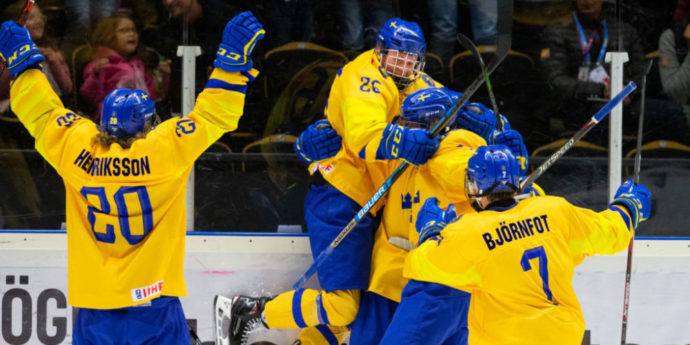
NASHVILLE (The Draft Analyst) — Sweden boasts Europe’s premier development pool when it comes to producing NHL talent, so it shouldn’t be surprising that they are expected to once again lead the international community in drafted players this June. At the very top of the 2020 Euro class are a pair of Swedish wingers everyone should be familiar with — Alexander Holtz and Lucas Raymond. Not only is either winger a right-handed shot with sublime puck skills, but they also represent Sweden’s best chance to have two forwards picked in the top five of the draft since 1999, when future Hockey Hall of Famers Daniel and Henrik Sedin went second and third overall, respectively.
After the aforementioned Holtz and Raymond is a diverse collection of forwards and defensemen; some who lean towards the finesse side while others play a more well-rounded game. Based on my last rankings, anywhere from three to six Swedes have stated their cases to become first-round picks or close to it. Below are detailed reports on several of the best 2020 draft prospects Sweden has to offer.
1. Alexander Holtz
Right Wing | Djugardens, SHL | 6’0, 192 | 1/23/02 | 29gp-8g-6a-14pts

There’s only been two Swedish-born 40-goal scorers in the NHL since the 2005 lockout, but it’s time to place your bets on this hard-shooting sniper to become the next. Holtz is one of the top goal-scoring prospects to come out of Sweden in over a decade, and his mature play for Djugardens has helped him earn a regular shift and lead all SHL rookies with 14 points in 29 games. Holtz also was one of Sweden’s best forwards at the under-20 world junior championship in December. He’s a powerful skater with excellent balance and agility, but shooting the puck with incredible precision is how Holtz makes most of his money. He forces goalies to earn every save no matter what part of the offensive zone he lets if fly from.
For a detailed scouting report and video highlights, click here.
Here’s that Alexander Holtz goal from the other day. Short-side snipe with barely any room and did it on his own. #2020NHLDraft pic.twitter.com/O3aay6IlVc
— Steve Kournianos (@TheDraftAnalyst) February 13, 2020
2. Lucas Raymond
Left Wing | Frolunda, SHL | 5’11, 170 | 3/28/02 | 26gp-4g-4a-8pts

An aggressive dual threat with excellent speed and overall quickness, Raymond may very well be the first Swede taken off the board in June; possibly as high as the second overall pick. The stats are far from impressive, but keep in mind that his Frolunda Indians are a perennial SHL powerhouse with multiple league titles, thus making it difficult for a 17-year-old forward to have a significant role.
For a detailed scouting report and video highlights, click here.
5–3! Stortalangen Raymond visar både fart och kyla när han sätter matchens åttonde mål! @frolunda_hc #twittpuck #SHL pic.twitter.com/24JYMWZSEq
— C More Sport (@cmoresport) January 23, 2020
3. Emil Andrae
Left-handed Defenseman | HV71 J20, Superelit | 5’8, 181 | 2/23/02 | 35gp-10g-20a-30pts
This year’s Swedish crop is deeper at forward than on the back end, but this agile puck rusher has the highest upside in terms of point production at higher levels. Andrae is the primary option to swing momentum and control play from the point for both HV71 and Sweden’s under-18 team. He display a phenomenal touch when connecting on breakout passes, but he also has quick feet and a sudden speed burst that helps him dart into openings. Skating and playmaking, however, are just apart of the overall package. Andrae stands up at his defensive line and uses powerful leg drive to deliver clean hits. His timing while backskating could use some work, but the fact that he’s reading plays properly is a strong foundation to build off of.
Andrae boasts a hard, accurate shot, and he uses his lateral quickness and a variety of fakes to walk the line or get himself into the high slot for an improved chance at the net. He’s an incredibly intelligent player who rarely skates himself into trouble, but Andrae also knows how to create time and space on his own. He’s an excellent passer both on the move or from a static position, and most of his first passes are crisp and right on the tape. Few defensemen in his draft class can handle a forecheck as well as Andrae, who’ll use his speed and agility to escape trouble but also remain incredibly poised while letting pressure peel away.
His measurements may seem worrisome for a minute-eating rearguard, but Andrae is no slouch in the physical department and has shown excellent balance and competitiveness in puck battles. He does however take an excessive amount of minor penalties (his 16 minors in only 25 games are tied for the most in the Superelit’s South Division).
Here’s that goal by Emil Andrae in the 3-1 loss to Russia. High-IQ type stuff here, but if you watch enough of Andrae you know that’s par for the course. It’s a risky play that only a few defensemen his age can pull off. Nice work by Oskar Magnusson and Gabriel Sall to set it up. pic.twitter.com/uTaOkjrQoE
— Steve Kournianos (@TheDraftAnalyst) February 5, 2020
4. Zion Nybeck
Left Wing | HV71 U20, Superelit | 5’6, 182 | 5/12/02 | 36gp-19g-34a-53pts

A leading scorer for his club team and a top player for Sweden at the under-18 level, Nybeck is a smaller winger who uses his quickness and strong leg drive to make up for a lack of upper-body strength. He plays an aggressive style without the puck and is by no means intimidated by bigger opponents. Quick to the outside and brave enough to dart into the middle, Nybeck can be counted to enter the zone cleanly and make smart decisions thereafter. For all his efforts on or off the puck, Nybeck does go through brief moments where he is a non-factor, albeit before unleashing a string of dominant shifts that result in multiple quality scoring chances. Nybeck’s vision and passing off the cycle are both excellent, but he also knows when to peel away from a scrum and establish positioning in front of the net. In terms of special teams, HV71 has used him on the point with the top power-play unit and he has killed penalties with effectiveness.
Nybeck has incredibly soft hands and can settle the puck while in full flight. The puck seems to agree with him the majority of the time he controls it, and playing at a feverish pace doesn’t impede his ability to make sound last-second decisions. Nybeck is a smart forward who doesn’t rely on his speed and motor to compensate for a lack of understanding — This kid clearly gets it from both a positioning and vision standpoint. Opposing teams know full well that they need to target him, and attempts to throw him off his game via physicality and intimidation mostly fail. Nybeck draws a lot of attention, which in turn earns his team a high number of power plays.
One of the most noticeable aspects of Nybeck’s game is his wrist shot, although he has shown the ability to score using multiple methods such as the backhand. His shot definitely is more accurate than it is powerful, and scoring from either circle is commonplace. Nybeck’s a difficult subject for opposing goalies to grasp because his diverse skill set with the puck keeps them guessing in situations such as odd-man rushes, breakaways, and on the power play.
#U18: Swedes and Swiss were scoreless for nearly two full periods before the Swiss scored off a faceoff, then LHD Emil Andrae (Ranked No. 34) made a perfect home-run pass to a streaking RW Zion Nybeck (Ranked No. 32) to tie the game 1-1. pic.twitter.com/eqO1YYk9Gm
— Steve Kournianos (@TheDraftAnalyst) November 6, 2019
5. Noel Gunler
Right Wing | Lulea, SHL | 6’2, 176 | 10/7/01 | Shoots Right
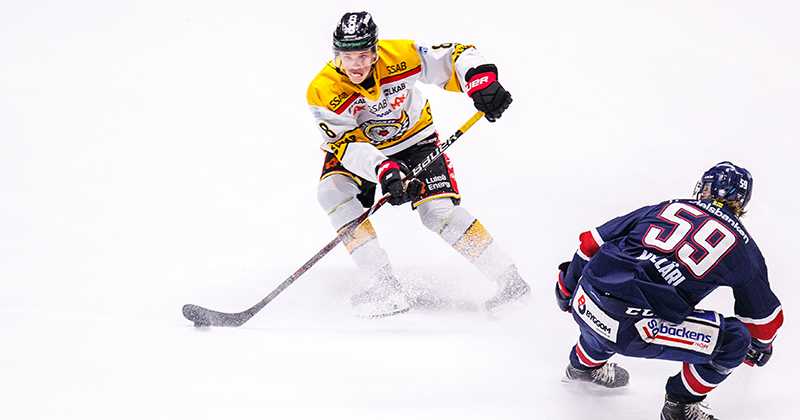
I’m not going to call Gunler a “divisive” prospect because clearly I’m in the minority by thinking he’s not a lock for the first round of the draft. Still, you have to give him credit for both earning and sticking with a depth role on the SHL’s best team, thus adding context to his pedestrian stats. His skill set is more than impressive, especially when you consider his dual-threat capabilities. Gunler’s skating being criticized is a bit odd to me because I don’t think I’ve ever seen an instance (other than at the end of a shift) where his foot speed, agility, or balance was problematic. He anticipates fairly well, albeit for someone who spends a lot of time on the periphery, and seems to get that critical jump to the puck before the opponent notices. Still, my view is that Gunler hasn’t done anything this year to particularly merit early first-round consideration, and all we have to go on is a dominant draft-1 season. Rather than “divisive”, I most definitely consider him the biggest boom or bust prospect for the 2020 draft, because if Gunler isn’t scoring or generating scoring chances, he’s rather ineffective.
For a more detailed scouting report and video highlights, click here.
6. William Wallinder
Left-handed Defenseman | MODO, Allsvenskan | 6’4, 191 | 7/28/02 | 18gp-0g-2a-2pts
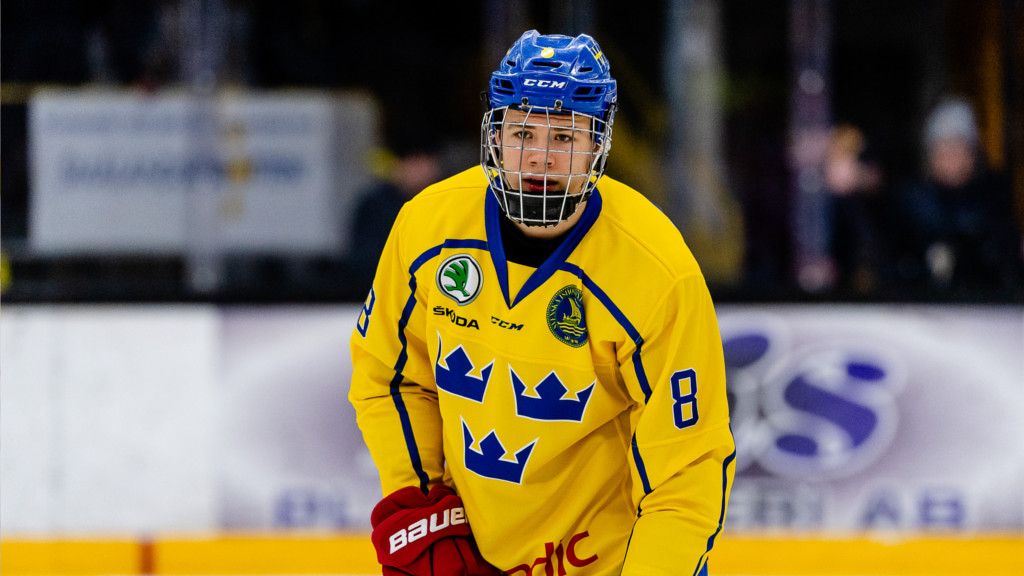
A heady two-way defender with top-pairing potential, Wallinder combines physical play with excellent mobility and solid puck skills. He dominated the J20 Allsvenskan to earn a midseason promotion to the adult-age Allsvenskan, where he served in a depth role but showed improvement and consistency as the season progressed. Blessed with a hard accurate shot and near-perfect skating abilities, Wallinder can fill any role and played between 23 to 25 minutes a game at both the junior and international level. One thing to keep an eye on is his health — Wallinder did not finish the under-18 Five Nations tournament from earlier this month and has not played any Allsvenskan games since.
For a more detailed scouting report and video highlights, click here.
7. Teddy Niederbach
Center | Frolunda J20, Superelit | 5’11, 172 | 2/25/02 | 36gp-13g-28a-41pts
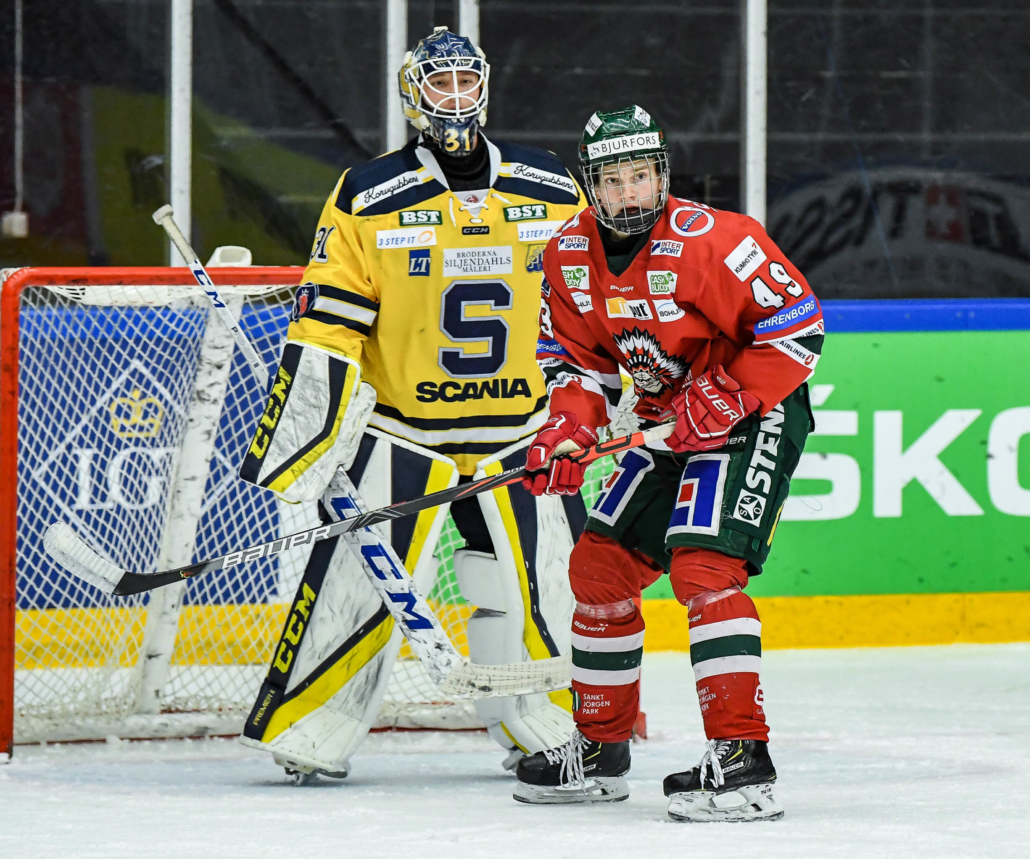
A tricky playmaking center with excellent vision and passing abilities, Niederbach has driven his own line to help Frilunda once again challenge for the Superelit crown. Niederbach has more than rebounded from a knee issue that forced him to miss all of last season. Not only does he rank in the top three in both assists and points on a talented Frolunda squad, but he’s been one of Sweden’s top producers in each of their two under-18 Five Nations tournaments this season.
Niederbach can be classified as an offensive-minded forward. He is neither big nor physical, but he plays with a fearlessness on the puck and in or around traffic. He’s an excellent stickhandler with soft hands and is able to delay from any location to survey the ice and identify his options. The heady nature of Niederbach’s game is evident the moment the puck is on his stick, although his overall on-ice demeanor seems more methodical and deliberate rather than intense and energetic. Niederbach’s calculated approach works out well for his mates, especially once he has the puck in the neutral zone en route to the opposing end. Defenders may think they can contain him in one-on-one situations, but like Eemil Viro found out at the Five Nations tournament, Niederbach can shift gears into a dangle and open lane to the net. There’s a high level of deception in Niederbach’s game, especially when he’s stickhandling at any speed inside the offensive zone.
When it comes to the power play, few can carve up an opposing penalty kill like Niederbach. The fact the he is a teammate of uber-playmaker Karl Henriksson and still led the Superelit with 16 power-play points tells you now only what Niederbach can do with the puck, but that his coach entrusts him with the critical role of set-up man on one of the league’s best teams. He often is incredibly patient with his back to the wall, but Niederbach also has that extra sense to spot the backdoor openings or gaps within the seam. He also boasts an effective wrist shot and quick release, and having the reputation as a precision passer usually forces goalies to play the pass and leave enough room on the short side for Niederbach to target.
Niederbach, who also plays wing, is a swift skater who seems to limit the amount of power he puts into his stride. This likely is due to the ongoing recovery from his knee condition, which may also explain how his efforts towards loose pucks lack a sense of urgency. Again, he’s a playmaking center tasked with creating scoring chances while simultaneously strengthening a knee that was out of commission less than a year ago. For what it’s worth, Mathew Barzal also suffered a serious knee injury before being drafted but his hands and vision remained elite.
Theodor Niederbach matchvinnande 4-3 mål för Frölunda mot Mora. #J18gifs #FHC #J18AllsvenskanSödra #2020NHLDraft pic.twitter.com/O3fQXEc364
— Anton Johansson (@antonj85) January 5, 2020
8. Daniel Torgersson
Left Wing | Frolunda J20 | 6’3, 199 | 1/26/02 | 35gp-22g-14a-36pts
Photo: Ari-Matti Ruuska
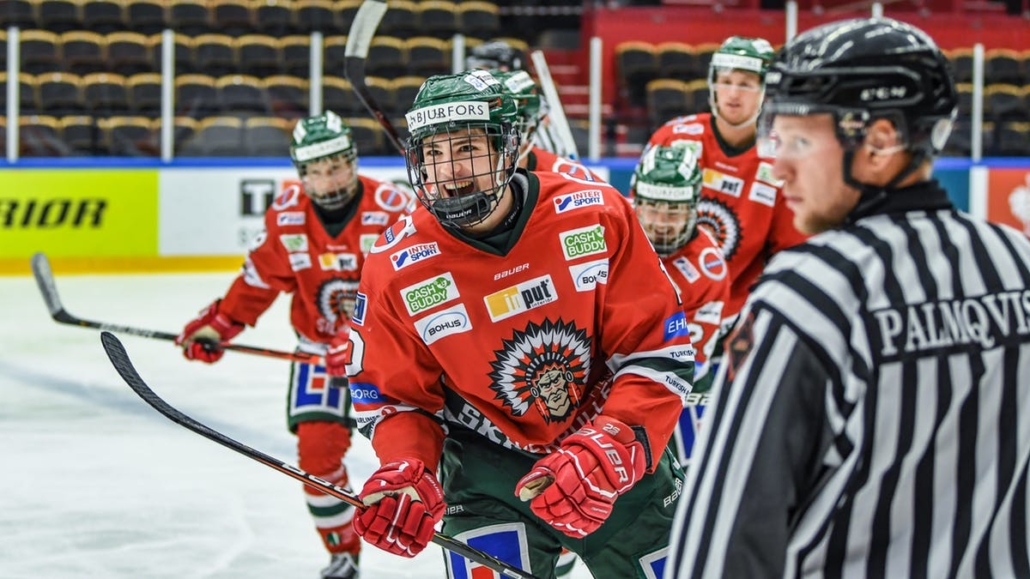
Torgersson is one of the hardest-working wingers you’ll find in this draft. Only a few, however, can provide the balanced approach and level of lethality he brings to puck possession. He is quite capable with the puck both in open ice and during close-quarter battles, and he can serve a variety of roles from net-front presence to one-timer option from the right circle. An energetic 6-foot-3 winger with soft hands and a plus shot like Torgersson is certainly a commodity, even in today’s NHL the average player appears to be shrinking. The thing is, Torgersson has a finesse element to his game and can match or beat most offense-first forwards in a skill-for-skill showdown.
Torgersson is a very good skater in all directions. He has a quick first step and can maneuver up the ice with speed and agility, but he also powers through checks near the opposing line and maintains possession for long stretches via quick feet and rapid directional changes. Keep in mind that these traits are analyzed within the context of a big-bodied winger who is expected to keep filling out as he moves closer to the NHL. Although he’s not overly fast in the classic definition of straight-line speed, Torgersson has shown to outmaneuver fleet-footed defenders to either gain the inside or outpace them in a 50/50 foot race.
Torgersson has seen a fair amount of time on both the power play and the penalty kill at the Superelit and international levels. He’s spent most of his season flanking either Teddy Niederbach or Karl Henriksson, but Torgersson’s style of play and impressive puck skills make him pretty low maintenance for any center. He also is an excellent penalty killer; one who is summoned by both Frolunda and Team Sweden to help kill 5-on-3’s or late/close situations. Torgersson can play a physical brand of hockey without overstepping the rulebook and is willing to take a beating on or off the puck regardless of the game situation.
For all the aforementioned strengths of his game, the most important are his goal scoring and accurate shot. Torgersson gets a ton of mustard on his wrister and always seems to be open enough to use it. For example, Torgersson will battle tooth and nail along the boards while dealing with multiple opponents, only to slip away undetected into a soft area for a clean look at the net. This is not easy to do when you play a loud game and stand 6-foot-3 in a junior league. Nonetheless, Torgersson makes every shift count, and his ridiculous league-leading shooting percentage (31.7 percent) is a testament to that.
9. Helge Grans
Right-handed Defenseman | Malmo J20, Superelit | 6’3, 206 | 5/10/02 | Shoots Right | 25gp-4g-23a-27pts

A rangy defender with soft hands and good mobility, Grans was one of the Superelit’s top point-producing rearguards before a midseason call-up to the SHL. He represented Sweden at the recent under-18 Five Nations and Ivan Hlinka tournaments, albeit with marginal success. Still, Grans reveals an intriguing combination of size and speed, plus the ability to run a power play and execute clean breakouts. When all aspects are humming, Grans can be the best player on the ice well beyond simply taking the puck for a skate or slinging pucks on net. Granted, he holds a significant size advantage over most teenage opponents and plays in a league not necessarily known for a physical forecheck. In the Superelit, however, Grans has shown incredible poise under pressure and is consistent in the amount of times he faces an oncoming forechecker, only to leave him in the dust within a matter of seconds.
Although his assist totals are high for a first-year draft eligible (23 in 25 games), Grans isn’t a classic playmaker from the back end. Most of his 14 points from the power play were via rebounds from point shots or simple cross-point passes. To his credit, Grans puts the right touch on the puck while delivering it on the tape. His vision inside the offensive end is solid but somewhat limited to a small radius — if you’re open and visible, Grans will get you the puck. He does seem to gravitate towards the puck during board battles, whereas a defender such as fellow Swede Emil Andrae will treat a nearby struggle near the wall as a chance to get open for a quick pass off the scrum.
Defensively, Grans is adequate in the most critical areas of defense — slot coverage; one-on-one play; penalty killing; crease clearing. He relies heavily on his quick first step and long reach to break up plays, but understanding where he’s needed most remains a work in progress. Grans is a bit of a floater from the slot and likes to join his partner behind the net or in the corners when his presence might be required in the low slot. For all his size, quickness and the aforementioned reach, Grans isn’t all that smothering when it comes to neutralizing one-on-one rushes, and he can be a little standoffish at his own line. The bottom line is that Grans is not an intimidating presence but makes up for it with quick transition and the ability to be sure on the puck when his team needs him to be.
10. Oskar Magnusson
Left Wing | Malmo J20, Superelit | 5’10, 166 | 1/31/02 | Shoots Left | 34gp-22g-23a-45pts
A skilled two-way forward who can play center or wing, Magnusson has been a top-line player for Malmo for most of the season, in addition to contributing for Sweden at the under-18 Ivan Hlinka and both Five Nations tournaments. Magnusson is more than energetic and his efforts on or off the puck are both consistent and effective. The Redhawks are rebounding from a terrible year last year, and Magnusson’s two-way play and lethality with the puck are key contributors to this resurgence.
Magnusson is noticeable the moment he hits the ice. His efforts while chasing the puck are tireless, and the same applies when covering gaps left by overcommitting teammates. He makes excellent reads both in the neutral zone and near his line, and once he collects the puck, Magnusson will motor up the ice and accelerate well past opposing pressure. He also can slow things down and enter the zone deliberately while keeping his head up in search of trailing teammates rather than worrying about getting plastered into the boards. Magnusson is a very tricky player, however, and attempts to seal him off or nail him once he’s inside the blue line are exploited with a nifty juke or shimmy that leads to a patch of open ice and a number advantage.
Magnusson is a threat on both the penalty kill and the power play. While shorthanded, Magnusson will apply intense pressure to the points while keeping his stick blade in likely passing lanes. He already has a reputation as a gambler willing to bank on his speed to handle overcommitments, yet opposing defenders continue making the same rushed mistakes while trying to avoid him. Thus, Magnusson seems to be involved in multiple odd-man rushes a game and should be regarded as one of the top breakaway threats in the league. During the man advantage, Magnusson stays in constant motion and will either set up for a one-timer from the circle or look to thread the needle across the seam from the half wall. He is confident in his ability to lure opponents towards him before floating or saucering a pass into an area where a point man can step into a blast from in between the circles. It’s no coincidence that Malmo owns the South’s top power-play unit and No. 2 penalty kill.
#U18: Malmo C/W Oskar Magnusson (Ranked No. 121) slings one home on the PP to up Sweden’s lead over Switzerland to 3-1 in the 3rd. Very energetic and seems to bring max effort every shift. pic.twitter.com/W0fEMMOngb
— Steve Kournianos (@TheDraftAnalyst) November 6, 2019
11. Elliot Ekmark
Center | Linkoping J20, Superelit | 5’9, 162 | 1/29/02 | Shoots Left | 27gp-10g-14a-24pts
Elliot Ekmark gjorde 4-1 till Linköping mot HV71, assisterad av Albert Lyckåsen och Marcus Pedersen. #J20gifs #lhchockey #2020NHLDraft pic.twitter.com/MNrTchHKNc
— Anton Johansson (@antonj85) November 1, 2019
Ekmark is practically a spitting image of Oskar Magnusson when it comes to on-ice demeanor, mannerisms with the puck, and versatility. He’s incredibly quick and fearless for an undersized forward, and Linkoping J20 has given him critical roles on a team considered to be the best and deepest in the Superelit. He also has played for Sweden at high-profile international tournaments at both the under-17 and under-18 levels.
Ekmark is an excellent skater who is quick with his first step and rapid with his lateral movements. Having a slight frame hinders him in the balance department, but you can’t hit what you can’t catch, and Ekmark has made a habit of taking larger defensemen to the woodshed when it comes to one-on-one entry attempts. He’s an inside player willing to sacrifice his body while taking the puck into the middle of the ice. One thing to consider is that Linkoping boasts a lineup loaded with size and muscle, but it is the 5-foot-9 Ekmark who consistently stands out when it comes to throwing his weight around and finishing his checks.
12. Hugo Styf
Left-handed Defenseman | MODO J20, Superelit | 6’1, 188 | 8/25/02 | Shoots Left | 36gp-7g-10a-17pts
A hard-hitting puck rusher who’s had the misfortune of being stuck behind strong defense prospects at both the club and international level, Styf arguably is the most physical of Sweden’s notable draft-eligible defensemen. He may not be the strongest skater or the most skilled defender on the ice at a given time, but Styf plays with a fearlessness rarely seen in Sweden’s top junior circuits. His role and scope of responsibilities has increased since William Wallinder was promoted to the Allsvenskan, as he’s played on MODO J20’s top pairing while looking impressive since his return from the Five Nations tournament from earlier this month.
Styf is an aggressive puck mover who is willing to take the puck the length of the ice and enter the opposing zone on his own. His entries are generally clean and calculated, and although he’ll resort to mostly dump-ins, Styf isn’t afraid to venture deep inside or stop on a dime and connect with a trailer across the ice via a crisp, accurate pass. Once his forwards execute their cycle game, Styf will activate into the circle for a hard shot at the net. He likes to pinch and seems confident in his quickness and backskating to recover in the event of a change in possession.
Defensively, Styf’s overall shutdown abilities are slightly average. He has moments where he provides blanket coverage in either the neutral zone or slot area; in others, he can looked lost and indecisive. Styf has good size and a long reach but at times he seems to rely too much on his physicality to win chest-to-chest battles when a simple poke check or hard shove would be more effective. The fact is simple — Styf looks to hit everything no matter where or when, and this desire often catches him out of position.
Styf is an upright skater with a short stride, but he moves with a purpose and can excel in open ice. He puts a nice touch on his passes during breakouts and delivers them with accuracy. He also isn’t afraid to control the puck for long periods and is willing to take the puck into traffic with a pretty high success rate. There are times where he looks more like a forward than a defenseman, mainly because of his impressive puck skills and ability to create chances. Physicality aside, however, there remains room for refinement to the way he defends his position.
LHD Hugo Styf (#7 White) is a sleeper for the #2020NHLDraft. Has good size, quick feet and also a big hitter when necessary. Here he’s physical along the boards, makes a crisp pass on the tape through traffic, then darts in for a nice finish. Plays for the U18 squad as well. pic.twitter.com/doapnwyVnm
— Steve Kournianos (@TheDraftAnalyst) December 1, 2019



